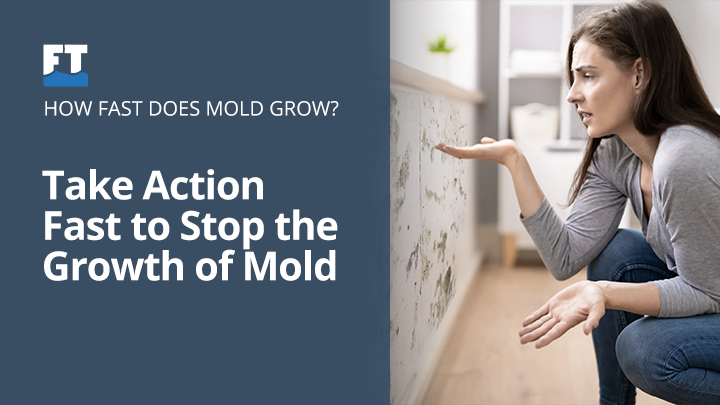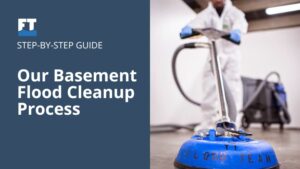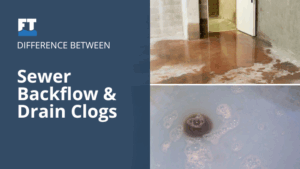Water damage can feel like a disaster, and when mold starts to grow, it only gets worse. Not only does mold damage your home, but it also creates health risks that you want to avoid. So, how long does it actually take for mold to start growing after water damage?
The timeline can vary depending on several factors, but the sooner you act, the better. Let’s break it down.
The Mold Growth Timeline
Immediate Effects (0-24 Hours)
When water enters your home, the clock starts ticking. Within the first 24 hours, mold spores can begin settling on damp surfaces. The moisture creates a breeding ground for mold, which thrives in warm, humid environments. Though it’s rare for mold to fully grow in this short time, it’s crucial to take immediate action. The longer water sits, the more chance mold has to take hold.
If you notice water damage in your home, it’s vital to start the drying process as soon as possible. Even if mold isn’t visible yet, those early hours are key to preventing it.
Early Growth (24-48 Hours)
Between 24 to 48 hours, you’ll start to see more obvious signs of mold growth if the moisture hasn’t been addressed. Mold spores are everywhere, and with the right conditions—humidity, warmth, and moisture—they’ll begin to grow. Most types of mold grow quickly, especially in places like basements, bathrooms, or areas that stay damp.
At this stage, mold can easily spread if you don’t act fast. While some types of mold take longer to appear, many can start to take hold in as little as 48 hours. The sooner you dry out the affected areas, the more likely you are to avoid a full-blown mold infestation.
Full Mold Colonization (3-12 Days)
By the time three to twelve days have passed, mold will be well on its way to colonization. This is when you’ll see visible patches of mold growing on walls, ceilings, or floors. Mold can spread through porous materials like wood, drywall, and carpets, making it harder to clean. At this point, you’ll likely notice the telltale signs—musty smells and dark spots.
If you still haven’t addressed the water damage, expect mold to continue growing. And the longer it takes to remove the moisture, the harder it will be to eliminate the mold once it’s established—often requiring thorough mold remediation to get it under control.
Factors That Influence Mold Growth
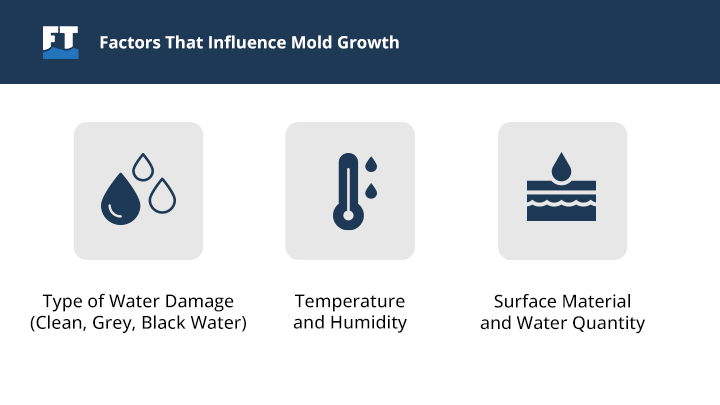
Type of Water Damage (Clean, Grey, Black Water)
The types of water damage that can influence how quickly mold will grow. Clean water, such as from a leaky pipe, might take longer to promote mold growth. However, grey water—water that has been used, like from a washing machine—and black water—contaminated water from floods or sewage—are ideal environments for mold. These types of water can introduce more contaminants and cause mold to grow faster.
Temperature and Humidity
Mold thrives in warm, humid conditions. The higher the humidity, the faster the mold will grow. In temperatures between 60°F and 80°F (15°C to 27°C), mold can spread quickly. If your home has high humidity, such as in areas without good ventilation, mold will have the perfect environment to flourish.
Surface Material and Water Quantity
The surface material also plays a role in mold growth. Porous materials like drywall, carpet, and wood absorb water, providing a perfect place for mold to grow. Non-porous materials like tile or metal are less prone to mold, but mold can still grow on the surface if moisture lingers long enough.
The quantity of water that causes the damage matters too. A small leak may take longer to cause mold than a large flood, but both will eventually contribute to mold growth if not dealt with promptly.
Preventing Mold Growth After Water Damage
Immediate Actions
If you experience water damage, take action right away. Dry out wet areas within 24 hours by using fans, dehumidifiers, and opening windows for ventilation. If the damage is extensive, consider calling a professional water damage restoration service. The quicker you act, the less likely mold is to take root.
Professional Help
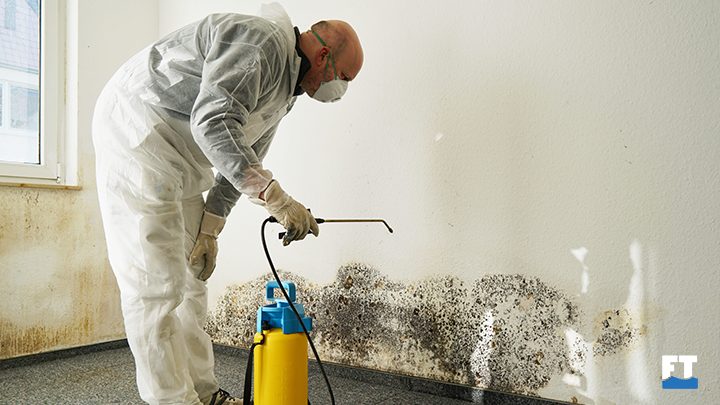
While you can do a lot of the initial cleanup yourself, professional help is essential for larger issues. A mold remediation company can thoroughly dry out your space, remove mold, and prevent it from returning. If you’ve had significant water damage, it’s always wise to consult with a professional.
Long-Term Prevention Tips
To prevent mold growth after water damage, keep your home well-ventilated, especially in high-moisture areas. Seal any leaks in the roof, windows, or plumbing. Keep humidity levels low by using dehumidifiers and installing exhaust fans in bathrooms and kitchens. Regularly check areas prone to dampness for early signs of water damage.
Don’t Wait For Mold to Take Over
If you’re unsure how to handle mold removal after water damage, companies that remediate mold—like The Flood Team—can provide the help you need. Mold is something you want to tackle right away, for both your health and your home’s safety. Contact us today to get expert help before the problem gets worse.

Final Thoughts
Mold can start growing within 24-48 hours of water damage, so it’s important to act fast. The longer you wait, the bigger the problem becomes. Whether you’re handling a small leak or a large flood, addressing the issue immediately is the best way to avoid a mold infestation.
FAQs
How quickly does mold grow after water damage?
Mold can start growing within 24-48 hours of water exposure, especially in damp environments. The sooner you dry the affected area, the less likely mold is to form.
What types of water damage cause mold to grow faster?
Black water (from sewage or floods) and grey water (from washing machines or dishwashers) can promote mold growth faster than clean water.
Can mold grow on non-porous surfaces?
Mold prefers porous surfaces like drywall and wood, but it can still grow on non-porous surfaces if moisture is present long enough.
How can I prevent mold after water damage?
Dry affected areas within 24 hours, ventilate the space, and consider using a dehumidifier. If needed, call a mold remediation professional for help.
What health risks are associated with mold?
Mold can cause respiratory problems, allergies, and worsen asthma. Long-term exposure can lead to serious health issues, especially in sensitive individuals.

